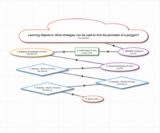
This is a 3 Roadmap series to address the identified standards.
- Subject:
- Geometry
- Mathematics
- Material Type:
- Lesson
- Provider:
- UMCDC
- Provider Set:
- Collabrify Roadmap Center
- Date Added:
- 02/24/2019

This is a 3 Roadmap series to address the identified standards.
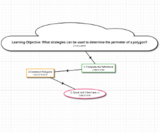
This is a 3 Roadmap series to address the identified standards.
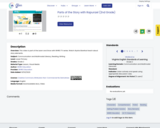
This video is part of the Learn and Grow with WHRO TV series. Watch Alystra Barefoot teach about story elements.
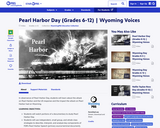
Students will learn about the attack on Pearl Harbor and the US response of the Pearl Harbor Day observance.
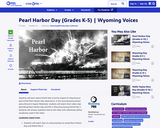
Students will learn about World War II and its impact on Wyoming as part of the Pearl Harbor Day observance.
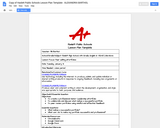
Objectives:
To create a professional Senior Leadership ePortfolio
To collaborate and discuss what makes a successful portfolio
To peer review portfolios using mindful and effective feedback
Essential Question:
What makes a successful portfolio?
What can I do to make my portfolio successful and professional?
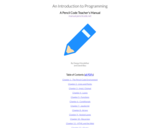
In this manual we will show how to use Pencil Code to explore programming. Pencil Code is a free programming tool available at pencilcode.net. Pencil Code was developed by Google engineer David Bau together with his son Anthony Bau, with open-source contributions from many others.
This manual is intended for a high school, an introduction to programming course. Students 9th, 10th and possibly 11th graders would benefit from taking this course. An advanced 8th grade student could take this. A typical math pre-requisite of pre-algebra would be sufficient to take this course.
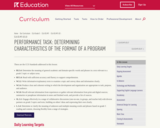
In this lesson, students analyze model programs and a model Directors' Note to understand the format of these texts. They read the model Directors' Note for gist and use it to begin planning their monologue group's Directors' Note as part of the module performance task (RI.5.4, W.5.2, W.5.4, W.5.8, SL.5.1, L.5.4).
Consider that some students may be able to rely on background knowledge about plays and theater when discussing the programs and Directors' Notes. Spend extra time contextualizing these concepts if necessary. Display photographs or brief videos of plays and directors working with actors. Also consider inviting students to share experiences with plays and theater in their home languages and cultures.
The Opening of this lesson is designed for students to use internet sources as texts. If the technology necessary for students to complete the reading is unavailable, provide them with a printed copy of the texts.
In the Closing, students generate criteria for reading fluency on the Fluent Readers Do These Things anchor chart in preparation for Part III of the End of Unit 3 assessment and performing their monologues as part of the module performance task (RF.5.4).
This lesson focuses on the following habits of character: working to contribute to a better world and working to become effective learners. The characteristics that students are reminded of in this lesson are: apply my learning when discussing the module performance task and perseverance before reading the model Directors' Note.
Students practice their fluency in this lesson by following along and reading silently as the teacher reads the model Directors' Note in Work Time A and by developing criteria for fluent reading in the Closing.
The research reading that students complete for homework will help build both their vocabulary and knowledge pertaining to human rights. By participating in this volume of reading over a span of time, students will develop a wide base of knowledge about the world and the words that help describe and make sense of it.
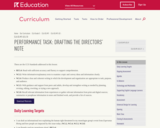
In this lesson, students use their research from Lessons 8-9 to write a draft of their Directors' Note with their monologue group (W.5.2, W.5.4, W.5.5, W.5.8).
In Work Time B, students are guided through a research reading share. Consider using the Independent Reading: Sample Plan if you do not have your own independent reading review routines. This review is designed to hold students accountable for their research reading completed for homework. This volume of reading promotes students' growing ability to read a variety of literary and informational texts independently and proficiently (RI.5.10, RL.5.10, SL.5.1).
This lesson focuses on the following habits of character: working to become effective learners and working to become ethical people. The characteristics students are reminded of in this lesson are: collaboration, as they work with their groups to write their Directors' Note, and taking initiative, prior to sharing their independent reading.
In the Closing, students practice reading their monologues in preparation for Part III of the End of Unit 3 Assessment and the performance task (RF.5.4).
The research reading that students complete for homework will help build both their vocabulary and knowledge pertaining to human rights. By participating in this volume of reading over a span of time, students will develop a wide base of knowledge about the world and the words that help describe and make sense of it.
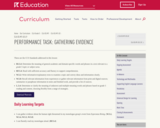
In this lesson, students continue to research and gather evidence for their monologue group's Directors' Note. They research issues related to human rights, select a right that their issue fits under, and learn about how the issue impacts people today (W.5.2, W.5.8). Specific examples of current issues have not been provided in this lesson, as situations can change very quickly. To ensure the content students are researching is up-to-date, websites that describe current threats to human rights have been suggested and will need to be reviewed in advance to identify the issues and the specific web pages that align with the threats to human rights students have highlighted in their monologues (see Technology and Multimedia).
This lesson is designed for students to use internet sources as texts. If the technology necessary for students to complete the reading is unavailable, consider providing them with a printed copy of the texts.
At the end of the lesson, students practice reading their monologues in preparation for Part III of the End of Unit 3 Assessment and the performance task (RF.5.4).
This lesson focuses on the following habits of character: working to become ethical people and working to become effective learners. The characteristics that students are reminded of in this lesson are: respect when sharing ideas during a whole class discussion and perseverance before reading internet research.
The research reading that students complete for homework will help build both their vocabulary and knowledge pertaining to human rights. By participating in this volume of reading over a span of time, students will develop a wide base of knowledge about the world and the words that help describe and make sense of it.
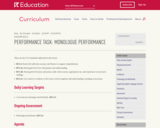
In this lesson, students present to an audience (RF.5.4). This may take longer than the allocated 50 minutes, depending on the number of students in the class.
This event could work in different ways: All students could present to the audience one by one, or students could be situated on individual stations in a larger room to present. Consider what will be most successful in your situation with your students.
In this unit, the habit of character focus is on contributing to a better world. The characteristic students are reminded of in this lesson is apply my learning, because they are sharing what they have learned about human rights with an audience.
The research reading that students complete for homework will help build both their vocabulary and knowledge pertaining to human rights. By participating in this volume of reading over a span of time, students will develop a wide base of knowledge about the world and the words that help describe and make sense of it.
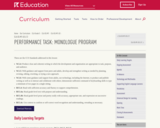
In this lesson, students work in their monologue groups to publish their programs. This lesson is largely dependent upon students having access to a computer and a printer. Consider giving students additional time to type their final copies. If technology is not available in sufficient numbers for your class, consider modifying this lesson to use standard print dictionaries and focus on students using neat handwriting to create a published copy of their programs using the Performance Task template (see Performance Task Overview) (W.5.4, W.5.5, W.5.6).
Time has been allocated in Work Time A for students to complete Part III of the End of Unit Assessment (RF.5.4).
In this unit, the habit of character focus is on working to contribute to a better world. The characteristic students "collect" in this lesson is taking care of shared spaces as they use shared computers to publish their programs, and apply my learning as they work to publish their performance task.
During the Closing and Assessment, students reflect on their learning using the Tracking Progress: Reading Fluency recording form. This exercise is meant to provide them with time to formally keep track of and reflect on their own learning. This self-reflection supports metacognition and pride in work and learning.
The research reading that students complete for homework will help build both their vocabulary and knowledge pertaining to human rights. By participating in this volume of reading over a span of time, students will develop a wide base of knowledge about the world and the words that help describe and make sense of it.
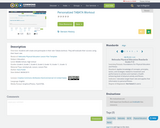
Students will create and participate in their own Tabata workout. They will evaluate their success using their heart rate.
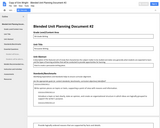
Teaching the features of persuasive marketing and writing.

An adaptable writing frame for teacher to comments; self evaluation and an indicator of whether the work was independent, shared or teacher assisted etc.
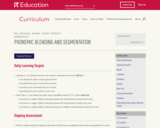
Opening A: I can identify the name and sound for consonants and vowels. (RF.K.3)
I can identify the name of each uppercase letter.
I can identify the name of each lowercase letter.
I can look at each consonant and say its sound.
I can identify the short sound for each vowel.
Work Time A: I can identify the initial, final, and middle sounds in CVC words. (RF.K.2d)
I can listen to a single-syllable word and pronounce the initial phoneme (sound) in the word.
I can listen to a single-syllable word and pronounce the final phoneme (sound) in the word.
I can listen to a single-syllable word and pronounce the middle vowel phoneme (sound) in the word.
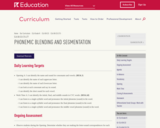
Opening A: I can identify the name and sound for consonants and vowels. (RF.K.3)
I can identify the name of each uppercase letter.
I can identify the name of each lowercase letter.
I can look at each consonant and say its sound.
I can identify the short sound for each vowel.
Work Time A: I can identify the initial, final, and middle sounds in CVC words. (RF.K.2d)
I can listen to a single-syllable word and pronounce the initial phoneme (sound) in the word.
I can listen to a single-syllable word and pronounce the final phoneme (sound) in the word.
I can listen to a single-syllable word and pronounce the middle vowel phoneme (sound) in the word.
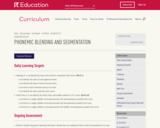
Opening A: I can identify the name and sound for consonants and vowels. (RF.K.3)
I can identify the name of each uppercase letter.
I can identify the name of each lowercase letter.
I can look at each consonant and say its sound.
I can identify the short sound for each vowel.
Work Time A: I can identify the initial, final, and middle sounds in CVC words. (RF.K.2d)
I can listen to a single-syllable word and pronounce the initial phoneme (sound) in the word.
I can listen to a single-syllable word and pronounce the final phoneme (sound) in the word.
I can listen to a single-syllable word and pronounce the middle vowel phoneme (sound) in the word.
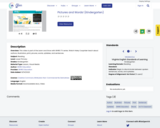
This video is part of the Learn and Grow with WHRO TV series. Watch Haley Cooprider teach about authors, illustrators, print, picures, words, syllables, and sentences.

Example showing 25 using place value